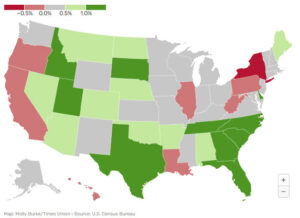The state lost more than 101,000 residents and for the third consecutive year had the highest decline in the country

New York lost more than 101,000 residents in a one-year period ending July 1, leading the nation in population decline for the third year in a row.
ALBANY — New York’s population exodus continued to top national charts for a third consecutive year with a loss of more than 101,000 residents from the Empire State, according to the most recent data from the U.S. Census Bureau.
The 0.5 percent decline in population, which occurred during a one-year period ending July 1, was less than the previous year’s 0.9 percent decline.
Texas and Florida continued to see the country’s highest population increases, adding more than 473,000 and 365,000 residents, respectively, followed by North Carolina and Georgia, which each added more than 100,000 residents during the one-year period.
Regionally, the South continues to lead the United States in population growth and has remained the most populous region, while the Northeast led the nation in decline and remains the least populous. Among states in the Northeast region, only New York and Pennsylvania saw declining populations this year.
The census report said that the country is returning to pre-pandemic levels, experiencing an increase of 1.6 million people and seeing more states with growing populations this year than since the start of the pandemic.
New York continues to be the fourth-most populous state, trailing California, Texas and Florida.
New York’s population exodus continues
More states gained than lost population during the 12-month period ending July 1. But New York logged the largest decline in the nation, losing more than 100,000 residents.

U.S. Rep. Elise Stefanik, who represents the North Country and parts of the Capital Region, blamed the decline on “the consequences of far left Democrat leadership.” Stefanik, chair of the House Republican Conference, said lawmakers in Albany have an “extremist agenda.”
“Far left Kathy Hochul and Albany Democrats have made New York so unlivable that our state leads the nation in population loss with more than 102,000 residents leaving in one year alone,” Stefanik said in a statement. “With record crime and cost of living far beyond the national average, New York’s mass exodus is far from over.”
The Empire State also has topped states in declining populations since the pandemic, losing more than 631,000 residents between April 2020 and July, representing 3.1 percent of the state’s population.
In the Capital Region, residents left in higher numbers than they came in between 2020 and 2021, except for Saratoga County, which added 2,000 residents.
During that same time period, the Hudson Valley gained residents, while New York City and nearby counties lost population.
The following year, Albany and New Rochelle were the only cities among New York’s 12 most populous that added residents. In the year ending July 1, 2022, Albany’s addition of 91 residents boosted the population to 100,826. New Rochelle’s growth was more robust, with an increase of 899 people to 82,288 during that period.
New York, which the census report estimated to have just over 20.2 million residents in April 2020, had fallen to less than 19.6 million residents in July.
The state’s public school population has also seen a steep, nation-leading decline since the pandemic, according to data collected by the Associated Press.
The state experienced a 6 percent decline in public school enrollment — a reduction of about 157,000 students — from the 2019-20 to 2022-23 school years, the largest percent decrease of any state that has reported the data. (Tennessee has not yet released recent enrollment figures.)
Every county in New York experienced an enrollment drop in that time period with the most pronounced decreases in New York City, as well as Greene, Schuyler, Ulster and Columbia counties, state data shows.
The number of students attending public school in the state is down 10 percent from a decade ago and is at its lowest level since the mid-1950s, according to Ken Girardin, director of research at the Empire Center, a non-profit think tank in Albany.
The Schuyler Center for Analysis and Advocacy released a report Thursday saying about 150,000 immigrants have arrived in New York between Oct. 1, 2022, and Aug. 1, including 30,000 children, a third of whom are under age 5.


 Jason Colannino performs Christmas songs on the Kamaka Ukulele
Jason Colannino performs Christmas songs on the Kamaka Ukulele